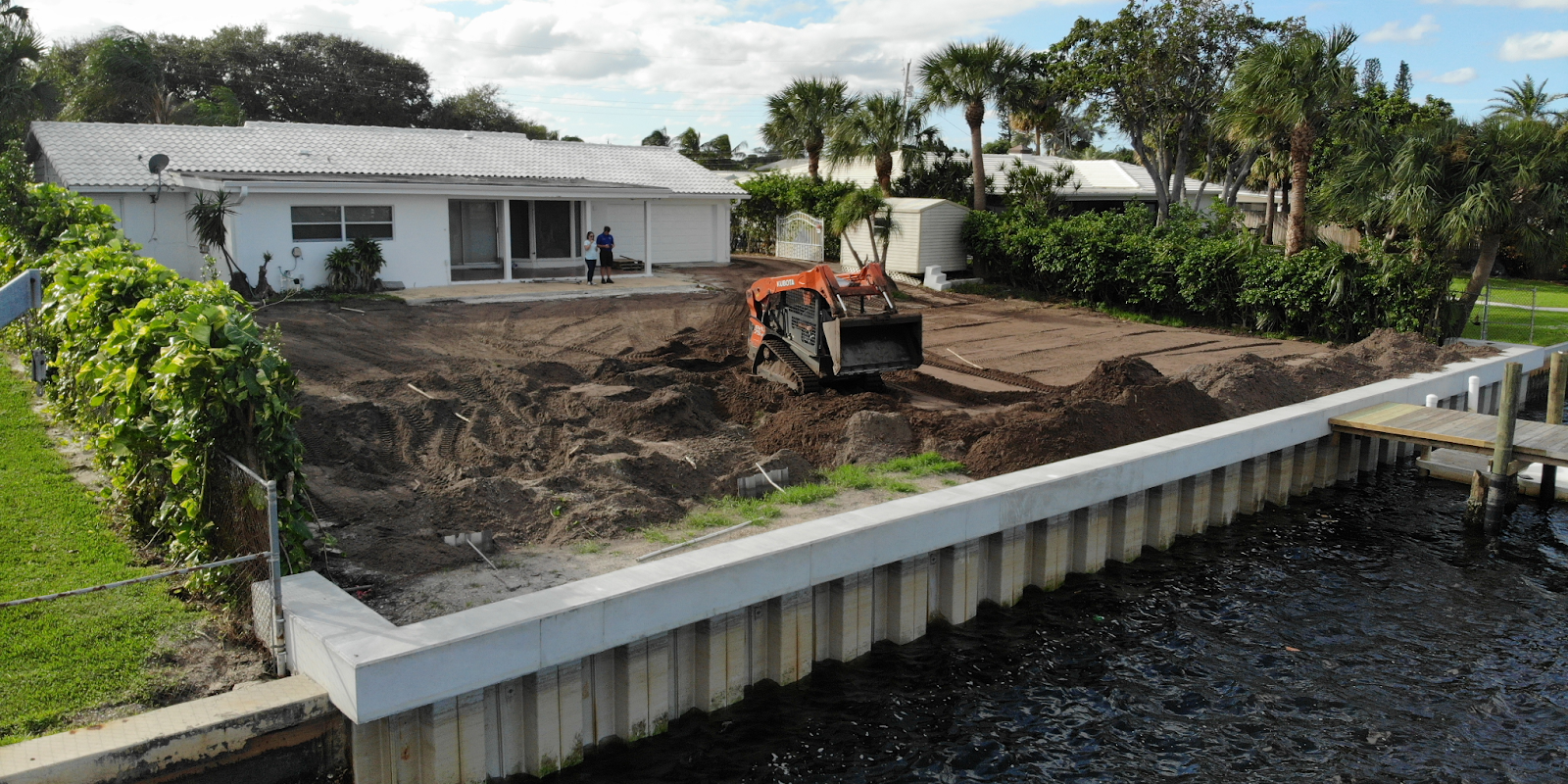Seawalls are critical structures that protect waterfront properties from erosion, flooding, and wave impact. They serve as the first line of defense against coastal forces, safeguarding both land and investments. However, like any structure exposed to constant environmental stress, seawalls require regular attention to ensure they remain effective.
This guide provides practical maintenance tips to extend the life of your seawall, from routine inspections and vegetation control to applying protective coatings and scheduling professional assessments. By following seawall maintenance and upkeep best practices, owners and maintenance personnel can increase durability, minimize costly repairs, and improve long term performance.
Why Seawall Maintenance Matters
A seawall in good condition not only protects your shoreline but also preserves property value and reduces liability. Without regular maintenance, even a well built wall can deteriorate quickly due to:
- Continuous water pressure and wave action
- Saltwater corrosion and mineral deposits
- Vegetation growth causing cracks and displacement
- Poor drainage leading to soil erosion behind the wall
Ignoring these issues often results in expensive reconstruction projects that could have been avoided with routine upkeep.
How to Maintain a Seawall
Effective seawall maintenance involves a mix of preventive care, timely repairs, and long term strategies. The following practices help ensure seawalls perform their protective role for decades.
1. Schedule Regular Inspections
Regular inspections are the foundation of seawall upkeep. Inspections help detect early signs of wear before they develop into structural failures.
- Frequency: At least twice a year, ideally before and after storm seasons.
- What to check:
- Cracks in the concrete or vinyl panels
- Signs of erosion behind the wall
- Leaning or bulging sections
- Joint or sealant deterioration
- Exposed or rusted reinforcements
Tip: Keep a maintenance log to track inspection dates, findings, and any corrective actions taken.
2. Keep the Seawall Clean
Debris, algae, and salt deposits accelerate material deterioration. A simple cleaning routine helps preserve the seawall’s appearance and function.
- Remove weeds and marine growth using non abrasive tools.
- Wash surfaces with mild detergents to prevent staining and corrosion.
- Avoid harsh chemicals that may weaken materials or harm marine life.
Best practice: Schedule seasonal cleaning to prevent buildup that masks hidden damage.
3. Perform Minor Repairs Promptly
Small cracks or gaps may not seem serious but can expand quickly under water pressure. Addressing them early is cost effective and prevents major failures.
- Use epoxy sealants for minor concrete cracks.
- Reapply joint sealants where panels meet.
- Replace small damaged sections rather than leaving them exposed.
Rule of thumb: A $100 repair today could prevent a $10,000 reconstruction later.
4. Control Vegetation Near the Seawall
Vegetation may look harmless, but tree roots and aggressive plants exert pressure that destabilizes seawalls.
- Trim or remove shrubs and trees close to the wall.
- Avoid planting deep rooted vegetation near the structure.
- Use ground cover plants that stabilize soil without damaging the wall.
Tip: Incorporate landscaping plans that complement seawall stability.
5. Manage Drainage Effectively
Poor drainage is one of the leading causes of seawall failure. Trapped water behind the wall builds up hydrostatic pressure, causing cracks and displacement.
- Ensure weep holes are clear and functioning.
- Inspect and clean drainage pipes regularly.
- Avoid directing downspouts or runoff toward the seawall.
Pro tip: Install proper backfill and filter fabric during seawall construction to support long term drainage.
6. Apply Protective Coatings
Exposure to saltwater and sun accelerates material degradation. Protective coatings extend the seawall’s service life.
- Use marine grade sealants or waterproof coatings on concrete surfaces.
- Apply anti corrosion treatments to steel reinforcements.
- Consider UV resistant coatings to prevent weathering.
Frequency: Reapply coatings every 3 to 5 years, depending on local conditions.
7. Schedule Professional Assessments
While property owners can perform routine checks, periodic professional inspections provide deeper insights.
- Engineers and contractors use specialized tools to detect hidden structural weaknesses.
- They can recommend targeted reinforcement, underpinning, or section replacements.
- Professional assessments are especially valuable after storms or visible damage.
Tip: Schedule a professional evaluation every 3 to 5 years or sooner if problems are suspected.
Table: Seawall Maintenance Practices at a Glance
| Maintenance Activity | Purpose | Recommended Frequency |
|---|---|---|
| Regular inspections | Detect early signs of damage | Twice yearly + post storms |
| Cleaning | Prevent algae, stains, corrosion | Seasonal |
| Minor repairs | Stop cracks and leaks from spreading | As needed |
| Vegetation control | Prevent root damage | Ongoing |
| Drainage management | Reduce hydrostatic pressure | Quarterly checks |
| Protective coatings | Extend material lifespan | Every 3 to 5 years |
| Professional assessments | Identify hidden structural weaknesses | Every 3 to 5 years |
Cost Saving Tips for Seawall Maintenance
Maintaining a seawall doesn’t always require large budgets. The following strategies reduce costs while extending service life:
- Be proactive: Fixing small cracks early is far cheaper than rebuilding.
- DIY cleaning: Regular cleaning with basic tools reduces professional service needs.
- Group maintenance tasks: Combine inspections, repairs, and cleaning in a single schedule.
- Budget annually: Set aside a portion of property maintenance funds for seawall care.
- Use durable materials: When repairing, invest in marine grade products for longer performance.
Longevity Strategies for Seawalls
Beyond routine maintenance, some long term practices help seawalls last decades.
- Reinforcement upgrades: Add tiebacks, anchors, or additional panels to strengthen aging walls.
- Erosion control landscaping: Plant salt tolerant grasses to stabilize soil near the wall.
- Wave deflection features: Installing riprap or barriers in front of the seawall reduces direct impact.
- Material modernization: Replace outdated timber or stone with modern vinyl, composite, or reinforced concrete.
When Seawall Maintenance Is Not Enough
Maintenance can extend a seawall’s life significantly, but there comes a point when replacement is the only viable option. Warning signs include:
- Severe leaning or bowing of the wall
- Large cracks running across multiple panels
- Continuous soil loss behind the wall
- Repeated costly repairs without lasting results
In such cases, consult a professional to evaluate replacement options.
Frequently Asked Questions (FAQs)
1. How often should I inspect my seawall?
At least twice a year, and always after major storms or unusual tidal events.
2. Can vegetation really damage seawalls?
Yes. Tree roots and shrubs exert pressure that can crack or displace panels.
3. What is the most common cause of seawall failure?
Poor drainage is the leading cause, as trapped water increases hydrostatic pressure behind the wall.
4. Do protective coatings make a big difference?
Absolutely. Coatings shield against saltwater, sun, and corrosion, extending service life by years.
5. How much does seawall maintenance cost annually?
Routine upkeep may cost a few hundred dollars per year, while neglect can result in tens of thousands in repairs.
6. Should I hire professionals for seawall maintenance?
Basic cleaning and inspections can be DIY, but professional assessments every few years are highly recommended.
7. How long does a well maintained seawall last?
Concrete and vinyl seawalls can last 30 to 50 years or more with proper care.
8. What should I do if I see erosion behind my seawall?
Address drainage immediately and consult a contractor for backfill replacement or structural reinforcement.
Conclusion
Seawalls are a long term investment that require consistent care to remain effective. By following seawall upkeep best practices from regular inspections and cleaning to minor repairs, vegetation control, and drainage management owners can dramatically extend the lifespan of these vital structures.
Incorporating protective coatings, maintenance schedules, and professional assessments ensures small issues are caught before they escalate, saving money and maintaining shoreline protection. At Coast Seawall Dock & Boatlifts, we emphasize proactive seawall maintenance strategies that not only enhance longevity but also secure the safety and value of waterfront properties for generations.








